calsfoundation@cals.org
Betty Dortch Russell McMath (1920–2019)
aka: Betty Dortch Russell
aka: Betty Russell
Betty Dortch Russell McMath became Arkansas’s most prominent portrait artist during the second half of the twentieth century. Her commissions included governors, judges, literary figures, and numerous business, civic, and social leaders. Beyond portraiture, her paintings seized the everyday moments of small-town life in Arkansas and chronicled its plantation culture. She produced portraits of five Arkansas governors, including Sid McMath, who was her second husband.
Betty Ruth Dortch was born on July 14, 1920, in Little Rock (Pulaski County), the daughter of Steele Dortch and Mabel Wittenberg Dortch. She had one sister, Judith. The family lived on 1,200 acres near Scott (Pulaski and Lonoke counties) in a home her father built. The house was situated on Bearskin Lake about one mile from Marlsgate, the home of her grandfather and family patriarch William Pinkney Dortch.
Betty Dortch attended elementary grades in a one-room school near her home; for fourth through sixth grade, she attended Scott Consolidated School. When she was about twelve years old, her parents allowed her to begin art lessons. Dortch transferred to the Little Rock School District’s East Side Junior High School and later Central High School, where she took art classes on perspective and glass painting. She graduated in 1938. Dortch then independently pursued art study with well-known teachers Adrian Brewer and Fern Edie Knecht.
After graduating from high school, Dortch entered Hendrix College in Conway (Faulkner County) and studied art with Louis and Elsie Freund. Dortch then enrolled in art classes at Washington University’s School of Fine Arts in St. Louis, Missouri. Dortch left school and returned to Arkansas in 1940.
Dortch’s first art commission was a portrait of Susan East, the six-year-old daughter of prominent Little Rock resident Jack East. Several years later, when the portrait was destroyed by fire, Dortch painted another portrait of Susan, then age nineteen.
In 1941, during World War II, Dortch met Henry Wellington “Rusty” Russell from Massachusetts, a 1937 graduate of Harvard University stationed in Little Rock. They were married on November 7, 1942. During World War II, he joined Allied troops for the D-Day invasion of Normandy, France, on June 6, 1944. When his overseas deployment ended, the Russells moved to Washington DC, where he was assigned to the Pentagon. Later, they spent six years in Boston, Massachusetts, before returning to Little Rock in 1951. They had five children. Rusty Russell died on June 3, 1983.
Throughout a seven-decade career, Betty Russell painted dozens of portraits for prominent Arkansas citizens. Among those were Pulitzer Prize recipient John Gould Fletcher, Little Rock political and social activist Adolphine Fletcher Terry, and U.S. District Judge Henry Woods. Her exhibit, Very Special Arkansas Women, made for the 1986 sesquicentennial celebration, featured a large group of notable women of Arkansas that included Betty Bumpers, Lily Peter, Bernie Babcock, and Annie Mae Bankhead.
Russell also produced portraits of five Arkansas governors: Orval Faubus, Winthrop Rockefeller, Daniel Webster Jones, Sid McMath, and acting governor Bob Cowley Riley. The portrait of Faubus depicts him sitting at his desk in a natural position, glasses in hand, leaning forward as if to speak with a constituent. Faubus admired the painting and wrote Russell a letter noting that Russell’s portrait gave him immediate distinction. In 1971, as Rockefeller’s term as governor ended, Russell was commissioned to paint his official portrait. Because Rockefeller’s associates and supporters wanted to present the portrait at a previously planned event, Russell had less than two weeks to complete the painting. She attended one of Rockefeller’s press conferences and solicited help from a young unknown photographer who did not seem busy but who, she later learned, was the governor’s son, Winthrop Paul Rockefeller. With Governor Rockefeller’s approval, Russell selected a Petit Jean Mountain site near his home as the background for his portrait. In the painting, Rockefeller is standing beside a monument to his mother’s favorite biblical verse (Micah 6:8), his Stetson hat in hand, looking into the valley below.
Russell was commissioned to paint the official portrait of Daniel Webster Jones, the nineteenth governor of Arkansas, because his picture in the Arkansas State Capitol had been damaged and required replacement. Russell had only a black-and-white photograph as a guide. Today, the painting is in the custody of the Old State House Museum, as what is now called the Old State House was the capitol when Jones served as governor.
In 1962, the North Little Rock Women’s Club developed a competition to decorate the flood wall between the Arkansas River and downtown North Little Rock (Pulaski County). Russell and a friend, Marge Holman, proposed a mural that would be 400 feet long and twelve feet high. Their winning idea depicted twelve panels based on the history of Arkansas from the earliest Native American settlements to modern times. The completed project was entered into a national City Beautiful contest and won fifth place. The mural underwent restoration in 2001.
For many years, Russell created paintings of the children who sold daffodils on the corner of Cantrell Road and Kavanaugh Boulevard in Little Rock. Jeannette Rockefeller bought one of Russell’s paintings to hang at Winrock Farms. During the early 1970s, when Russell’s youngest sons were early teens, they appeared in many of her drawings and paintings.
Russell was active in many civic and artistic organizations, including the Aesthetic Club, Mid-Southern Watercolorists, and Arkansas Artist Registry. Russell held more than a dozen solo exhibitions and received more than twenty competitive awards. In the late 1960s, her entries into the annual Arkansas Festival of the Arts took more than five top awards. In 2004, she was presented with the Arkansas Arts Council’s Governor’s Award for Individual Artist.
For thirty years, Russell taught painting, figure drawing, and art appreciation at the Arkansas Arts Center (now the Arkansas Museum of Fine Arts). While there, she was instrumental in starting an artmobile project that traveled throughout the state as well as children’s educational programs. Russell’s ties to the Scott community remained strong throughout her life, including being a founding member and the second president of Scott Connections, a group committed to collecting and restoring Scott’s heritage and to supporting the Plantation Agriculture Museum located there.
Russell was commissioned by former Arkansas governor Sidney McMath in 1994 to paint a portrait of his recently deceased wife, Anne. Their business arrangement turned to friendship and then to romance. They married on September 14, 1996. In 1998, she created a portrait of Sid McMath. The oil-on-canvas figure was unveiled at the first Arkansas Cultural Enrichment awards dinner, in Hot Springs (Garland County). This painting later became property of the Arkansas Governor’s Mansion. Sid McMath died October 4, 2003, in Little Rock.
In 2014, Betty McMath retired as an active artist and withdrew from Little Rock’s Cantrell Gallery, her art representative for many years. She died on December 26, 2019.
For additional information:
Houck, A. C. “A Word Portrait of a Painter of Portraits.” Arkansas Gazette, March 12, 1967, p. 5E.
McMath, Sid. Promises Kept: A Memoir. Fayetteville: University of Arkansas Press, 2003.
Rain, Judy. “Betty Dortch Russell.” Arkansas Gazette, February 8, 1987, pp. 1, 11.
Stanley, T. “Six Decades Covers Artistic Career of Betty Dortch Russell McMath.” Arkansas Democrat-Gazette, October 23, 1998, pp. 1E, 8E.
Yarbrough, Rebecca. Interview with Betty Dortch Russell, November 11, 1974. Oral History Collection. Center for Arkansas History and Culture. University of Arkansas at Little Rock, Little Rock, Arkansas.
Thomas A. Teeter
Little Rock, Arkansas

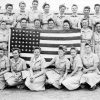

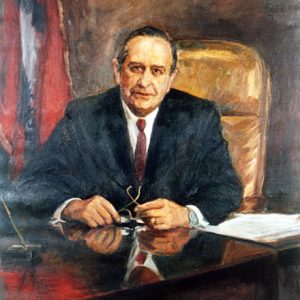
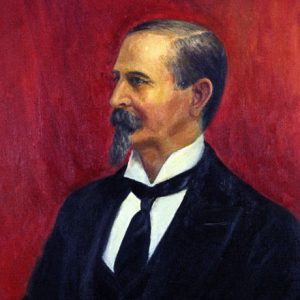
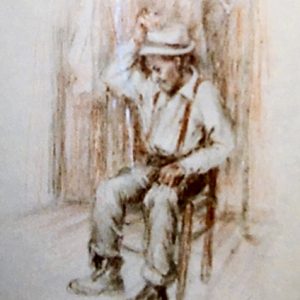
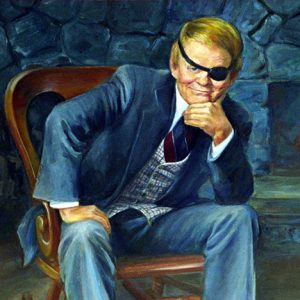
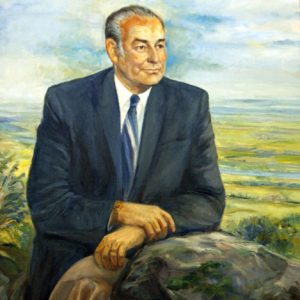
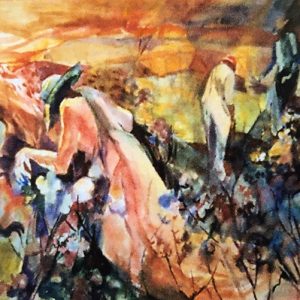
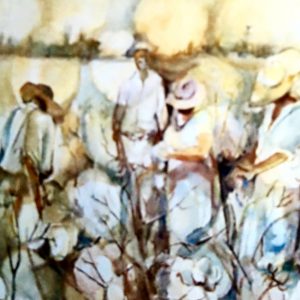




Mrs. Betty Dortch Russell painted my Great-Grandmother Bessie Harmon’s portrait. She is sitting in a rocker on the daffodil field of Wye Mountain, Arkansas. This portrait hangs in the Wye Mountain Community church at the daffodil field.